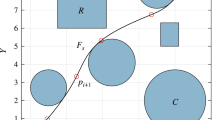Abstract
This paper proposed a modified artificial physics (AP) method to solve the autonomous navigation problem for mobile robots in complex environments. The basic AP method tends to cause oscillations in the presence of obstacles and in narrow passages, which can result in time consumption. To alleviate oscillation, we modified the AP method using the Levenbery-Marquardt (LM) algorithm. In the modified AP method, we altered the original directions of AP forces to the Newton direction, and adjust the parameter by the LM algorithm. A series of comparative experimental results show that the modified AP method can achieve smoother trajectories with less time consumption. This demonstrates the feasibility and effectiveness of our proposed approach.
Similar content being viewed by others
References
Spears W M, Spears D F, Hamann J C, et al. Distributed, physics-based control of swarms of vehicles. Auton Robot, 2004, 17(2–3): 137–162
Warren W S, Rabitz H, Dahleh M. Coherent control of quantum dynamics-the dream is alive. Science, 1993, 259(5101): 1581–1589
Adleman L. Molecular computation of solutions to combinatorial problems. Science, 1999, 266(5187): 1021–1024
Spears W M, Gordon D F. Using artificial physics to control agents. In: Proceedings of the IEEE Conference on Information, Intelligence, and System, Washington DC, USA, 1999. 281–288
Spears W M, Spears D F, Heil R, et al. An overview of physicomimetics. In: Swarm Robotics: Lecture Notes in Computer Science. Berlin: Springer-Verlag Press, 2005. 84–97
Jin Y C, Guo H L, Meng Y. A hierarchical gene regulatory network for adaptive multi-robot pattern formation. IEEE Trans Syst Man Cybern B, 2012, 42(3): 805–816
Jin Y C, Meng Y. Morphogenetic robotics: an emerging new field in developmental robotics. IEEE Trans Syst Man Cybern C, 2011, 41(2): 145–160
Olfati-Saber R. Flocking for multi-agent dynamic systems: algorithms and theory. IEEE Trans Automat Contr, 2006, 51(3): 401–420
Zhang H X, Zhang Z, Yuan X X, et al. Physical analysis and numerical simulation for the dynamic behaviour of vehicles in pitching oscillations or rocking motions. Sci China Ser E-Tech Sci, 2007, 50(4): 385–401
Duan H B, Liu S Q. Unmanned air/ground vehicles heterogeneous cooperative techniques: Current status and prospects. Sci China-Tech Sci, 2010, 53(5): 1349–1355
Khatib O. Real-time obstacle avoidance for manipulators and mobile robots. Int J Robot Res, 1986, 5(1): 90–98
Jing X J, Wang Y C, Tan D L. Artificial coordinating field and its application to motion planning of robots in uncertain dynamic environments. Sci China Ser E-Eng Mater Sci, 2004, 47(5): 577–594
Ren J, McIsaac K A, Patel R V. Modified Newton’s method applied to potential field-based navigation for mobile robots. IEEE Trans Robot, 2006, 22(2): 384–391
Ren J, McIsaac K A, Patel R V. Modified Newton’s method applied to potential field-based navigation for nonholonomic robots in dynamic environments. Robotica, 2008, 26(1): 117–127
Lourakis M I A. A brief description of the Levenberg-Marquardt algorithm implemened. 2005, http://www.ics.forth.gr/~lourakis/levmar/
Zhang Y P, Duan H B, Zhang X Y. Stable flocking of multiple agents based on molecular potential field and distributed receding horizon control. Chin Phys Lett, 2011, 28(4): 040503
Hettiarachchi S, Spears W M. Distributed adaptive swarm for obstacle avoidance. Int J Intell Comp Cybern, 2009, 2(4): 644–671
Zarzhitsky D V, Spears D F, Thayer D R. Experimental studies of swarm robotic chemical plume tracing using computational fluid dynamics simulations. Int J Intell Comp Cybern, 2010, 3(4): 631–671
Li P, Duan H B. Path planning of unmanned aerial vehicle based on improved gravitational search algorithm. Sci China-Tech Sci, 2012, 55(10): 2712–2719
Duan H B, Shao S, Su B W, et al. New development thoughts on the bio-inspired intelligence based control for unmanned combat aerial vehicle. Sci China-Tech Sci, 2010, 53(8): 2025–2031
Agirrebeitia J, Aviles R, Bustos I F, et al. A new APF strategy for path planning in environments with obstacles. Mech Mach Theory, 2005, 40(6): 645–658
Nocedal J, Wright S J. Numerical Optimization. New York: Springer Press, 1999
Yuan Y X, Sun W Y. Optimization Theory and Methods. Beijing: Science Press, 1997
Author information
Authors and Affiliations
Corresponding author
Rights and permissions
About this article
Cite this article
Zhang, X., Duan, H. & Luo, Q. Levenberg-Marquardt based artificial physics method for mobile robot oscillation alleviation. Sci. China Phys. Mech. Astron. 57, 1771–1777 (2014). https://doi.org/10.1007/s11433-013-5244-9
Received:
Accepted:
Published:
Issue Date:
DOI: https://doi.org/10.1007/s11433-013-5244-9




